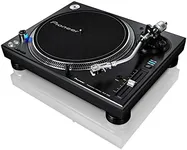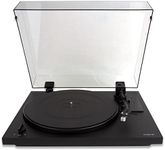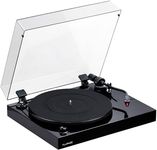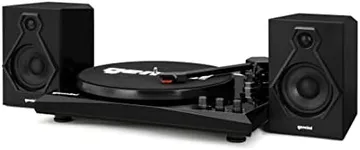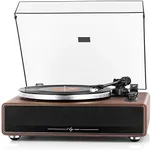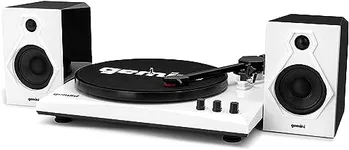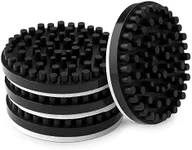Buying Guide for the Best Automatic Turntable
Choosing the right automatic turntable can greatly enhance your music listening experience. An automatic turntable is a device that plays vinyl records and automatically places the tonearm on the record and lifts it off when the record is finished. This feature makes it user-friendly and convenient, especially for those new to vinyl. When selecting an automatic turntable, it's important to consider several key specifications to ensure you get the best fit for your needs and preferences.Drive TypeThe drive type refers to how the turntable's platter is powered. There are two main types: belt-drive and direct-drive. Belt-drive turntables use an elastic belt to spin the platter, which helps reduce vibrations and can result in better sound quality. Direct-drive turntables have the motor directly attached to the platter, providing more consistent speed and quicker start-up times, making them popular with DJs. If you prioritize sound quality for home listening, a belt-drive turntable might be the best choice. If you need quick start-up and durability for DJing or frequent use, consider a direct-drive model.
Cartridge TypeThe cartridge is the component that holds the stylus (needle) and converts the grooves in the vinyl into an audio signal. There are two main types: moving magnet (MM) and moving coil (MC). MM cartridges are more common, easier to replace, and generally more affordable, making them suitable for most users. MC cartridges can offer superior sound quality but are typically more expensive and require a compatible phono preamp. If you're new to vinyl or looking for a reliable, cost-effective option, an MM cartridge is a good choice. If you're an audiophile seeking the best possible sound, you might consider an MC cartridge.
Built-in PreampA built-in preamp amplifies the signal from the turntable to a level that can be used by standard audio equipment. Some turntables come with a built-in preamp, while others require an external one. A built-in preamp can simplify setup and reduce the need for additional equipment, making it a convenient option for beginners or those with limited space. However, external preamps can offer better sound quality and more customization options. If you want a straightforward setup, look for a turntable with a built-in preamp. If you're looking to optimize sound quality and don't mind extra components, consider a turntable without a built-in preamp and invest in a high-quality external preamp.
Speed SettingsTurntables typically offer different speed settings to accommodate various types of records. The most common speeds are 33 1/3 RPM (revolutions per minute) for LPs (long-playing records) and 45 RPM for singles. Some turntables also support 78 RPM for older records. It's important to choose a turntable that supports the speeds of the records you plan to play. If you mainly listen to modern LPs and singles, a turntable with 33 1/3 and 45 RPM settings will suffice. If you have a collection of older 78 RPM records, ensure the turntable can accommodate this speed as well.
Platter MaterialThe platter is the part of the turntable that the record sits on. Platter material can affect sound quality and stability. Common materials include plastic, aluminum, and acrylic. Plastic platters are lightweight and affordable but may not provide the best sound quality. Aluminum platters are more durable and offer better sound quality due to their weight and stability. Acrylic platters are considered high-end and can provide excellent sound quality by reducing vibrations. If you're looking for a budget-friendly option, a plastic platter may be sufficient. For better sound quality and durability, consider an aluminum or acrylic platter.
Tonearm TypeThe tonearm is the part of the turntable that holds the cartridge and stylus. There are two main types: straight and S-shaped. Straight tonearms are simpler and can provide more accurate tracking, which is important for sound quality. S-shaped tonearms are often preferred by DJs for their durability and ease of use. If you're focused on achieving the best sound quality for home listening, a straight tonearm may be the best choice. If you plan to use the turntable for DJing or need a more robust option, an S-shaped tonearm might be more suitable.
